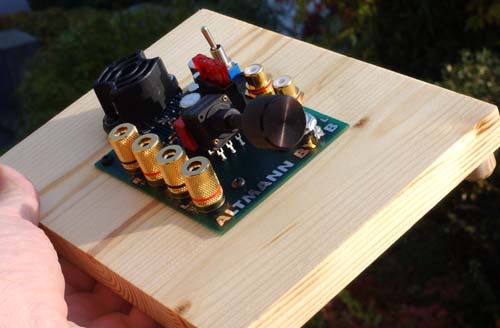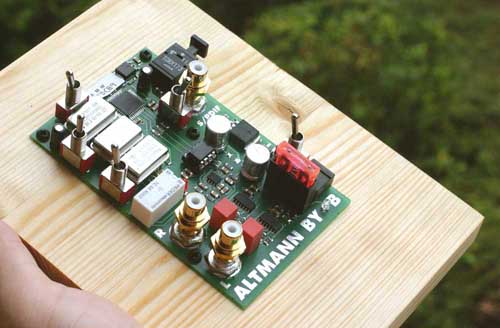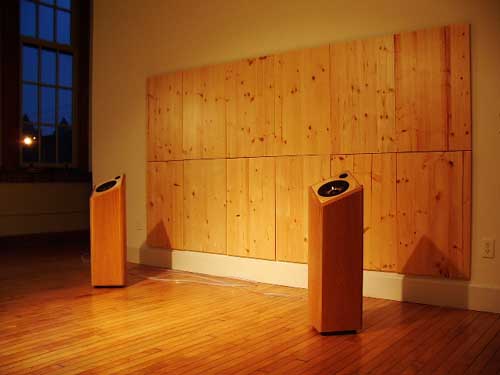این جمله رو تو ابتدای سایت BYOB (به معنی Bring Your Own Battery) میبینید که بنظرم جمله زیبایی هست و همانطور که قبلا گفتم درک Audio یک چیز Subjective هست و تا خود شنونده دنبال شنیدن صدا نباشه هیچ کتاب و نوشته ای به تنهایی نمیتونه بهش کمکی بکنه.
آقای Charles Altmann از آلمان صاحب برند Altmann Micro Machines که درباره خودش چنین نوشته :
Altmann Micro Machines is a german company focusing on the deliberate application of technology with the intent to improve customer’s wellbeing through procreation of uplifting and joyful experience. Specialty audio products and developments with a number of applied patents include the Altmann Superlative 24 bit / 96 kHz Digital to Analog Converter, The AMM – UPCI – Ultra Precision Clock Injector , the AMM JISCO – Jitter Scrambling Decorrelator ? the Altmann SPLIF – Split Feedback – Amplifier Topology , The Altmann Tube-o-Lator lacquer – a coating that makes semiconductors sound tube-like, the Altmann Do-it-Yourself Tonearm, The Altmann BYOB -Bring Your Own Battery- high performance vibrationally optimized audio amplifier and the Altmann Attraction DAC, a new and unique DA converter that can play up to 192kHz audio without oversampling and features extensive jitter filtering with dual VCXO precision PLL, switchable JISCO function, tube-o-lator-treated R2R converter, high-precision I/V conversion, and high power output and a vibrationally optimized desging employing a musical spruce sound-board. The Altmann Attraction DAC is the first DAC worldwide that can play fast sampled audio with zero-oversampling, sample by sample with unrivalled acoustic performance. Altmann Micro Machines was founded in 1994 by Dipl Ing. Charles Altmann.
Other Altmann Sites:
ساخته های دست این شخص قیمت خیلی پایینی دارند و میتونه مورد استفاده کسانی باشه که هم صدای خوبی میخواهند و هم هزینه براشون خیلی مهم هست.
سایت زیر رو ببینید که این شخص ساخته هاش رو گذاشته :
http://www.mother-of-tone.com/
فکر کنم این برند رو دوست خوبمون به نام heaven (من اسم دیگری از ایشون ندارم و با همین اسم ایشون کامنت میگذارند) معرفی کردند و من ازشون تشکر میکنم.
دوباره برمیگردم ، الان باید برم …
خب ، این آدم در ابتدای سایتش توضیحی داده که گفته اجازه بدید بجای پذیرفتن هر ایده ای ما ببینیم “تجربه به ما چی میگه” The experiment decides که بنظر من این جمله بسیار بسیار درست و مهم هست.
این نوع نگرش باعث میشه ما از فضای مورونی حاکم بر های فای که بیشتر ساخته پرداخته مجلات و فروشندگان هست دور بشیم و بجای بحث های احمقانه رایج X بهتر از Y هست و … ببینیم تجربه شنیداری چه چیزی رو به ما میگه. اتفاقا رومی هم روی این مساله تاکید زیادی داره و خیلی از نوشته ها و گفته های فضای های فای رو احمقانه میدونه.
آقای Charles Altmann در ابتدای نوشته هاش تاکید میکنه بهتره قبل از آشنا شدن با من اون ایده های قبلی رو که از جاهای دیگه به گوشتون رسیده و مبتنی بر تجربه شنیداری نبوده فراموش کنید، متن زیر رو دقیق بخونید :
Messages and Distortion
Imagine You would govern a large country with millions of people living there.
Then, not only a code of conduct or laws are needed for this country to work, but also messages.
A simple message would be: “It is good to be able to defend our country” or “wash your hands when leaving the bathroom”.
Why do you need messages? Well, messages are a tool to make your people stop thinking on their own and start functioning automatically in the way you intend.
If you – the governor of the country – think, that many people living in your country are somewhat stupid, then you would more likely rely on very simple messages.
For example: “It’s good for the economy and for the wealth of all of us to consume goods” or “Smoking cigarettes is bad for your health” .
And bang, your people are in trouble. This is a contradiction: Its good to consume but its bad to smoke. Distortion is what happens, when two messages are in conflict.
So a third message is needed, an exception, in order to resolve that conflict: “Its good to consume a product but its bad, when the product is a cigarette since it is able to cause illness”
When the message stops working, an exception is needed. Unfortunately life can be complex so a variety of exceptions are formulated:
“Buy a microwave but don’t put your pet in there”
“Enjoy your coffe, but caution, its extremely hot”
“Its great to have a 400hp sportscar, but beware of curves”
“Burgers are bad and salad is good, but salad with fried chicken is bad, it can have more fat than the burger”
“You must have that louder exhaust, but use it on the racetrack only”
Since You are not really the governor of the country (call me if you are), lets change the focus now. You live in the country and are bombarded with messages. The messages have been formulated in order to put you into a sleep-state and make you a functioning consuming entity with the illusion of individuality.
Since no message can work for all given aspects of life, you can indeed call them distortions, or in other words:
Distortion happens, when a simple message fails to fit into your view of the experience – you putting your pet in the microwave and being unsatisfied with the end result . That is Distortion.
Any message can only work for a limited view, and therefore I suggest the following practice:
a) try to identify the messages that reach you from the media (news, ads) and other persons.
b) find the messages that are triggered in your mind by any situation.
c) forget them all, its time to wake up.
Messages in Audio
There are many messages in the audio field. And many of them unquestioned, like the stuff you have put so much effort into learning in school or university.
These messages have been forwarded by the audio media, manufacturers and individuals.
Let’s take a brief look at the message salad:
“It must have flat frequency response”
“The harmonic distortion must be as low as possible”
“1000 Watts is better than 100 Watts is better than 50W is better than 10W is better than 3 Watts”
“The step response of the speaker don’t look good on the diagram”
“The cone must be made of a stiff material”
“SACD is better than DVD-A is better than CD, but Vinyl is best ”
Those messages have put you to sleep, so that you can simply sleep-walk into the next store and buy the stuff with the largest numbers: “I’m going to spend 10.000 bucks and I want 1000 Watts, 100 pounds, most zero’s on the distortion figure and the damn-highest sampling frequency you stock, sucker ! ”
You have already done that and it didn’t work out soundwise? You have followed all of the currently popular audio messages, and what you get is: Distortion.
Well, what do You think why You finally stranded here ?
So before continuing with this funny BYOB site, please forget all messages, at least those audio messages, so you don’t have to ask yourself (or me) boring questions concerning frequency-plots (yes, its flat) etc. (However, I am always thankful for interesting questions or remarks.)
But, as this site also contains messages – what else -, I would like to stress the point, that I don’t want you to unconditionally believe my stuff, I just want you to contemplate about it unprejudiced and awake.
The experiment decides
مطالب جالب دیگری هم خصوصا در مورد لرزش تو سایت ایشون هست :
http://www.mother-of-tone.com/listen.htm
http://www.mother-of-tone.com/vibration.htm
http://www.mother-of-tone.com/mother.htm
http://www.mother-of-tone.com/lacquer.htm
http://www.mother-of-tone.com/current.htm (این لینک خیلی جالب در مورد برق سیستم گفته حتما بخونیدش)
تو آخرین لینک بالا در مورد Power Supply اینطور میگه :
What makes a high-quality audio amplifier expensive ? It is the power supply
قبلا هم گقتم Solidstate های خوب مثل ASR و Vitus همشون تو طراحی Power Supply با بقیه فرق دارند. این آقا استفاده از باتری رو پیشنهاد میکنه کاری که ASR انجام داده و میدونید چقدر هم رومی روی مساله برق وقت گذاشته.

این آدم یک آمپلی فایر ساخته (شکل بالا رو ببینید) که با برق باطری اتوموبیل کار میکنه و 10 وات به 8 اهم میده که نیاز به بلندگوی با حساسیت بالا داره و کل قیمت درخواستیش 950 یورو هست.
دو مطلب هم در مورد فرمت دیجیتال نوشته که خیلی جالبه :
http://www.mother-of-tone.com/cd.htm
http://www.mother-of-tone.com/timeband.htm
حتما حتما دو لینک بالا رو بخونید. برخی شرکتها مثل EMM Labs بیشتر روی پاسخ پله تاکید دارند و برخی روی پاسخ فرکانس که این ادم میگه اگر رفتید به سمت بهتر کردن پاسخ فرکانس باید پاسخ پله رو هم بهینه نگه دارید.
و این آقا یک DAC خیلی خوب با قیمت 950 یورو ساخته که تو شکل زیر میبینیدش :

و اینکه ایشون فونو استیج هم ساختند.
ببینید در مورد ساخت بلندگو و انتخاب درایور چه حرف های جالبی زدند :
About Speaker Drivers
As I stated in earlier chapters, a good sound will be always present, when distortion mechanisms are absent.
The same holds true for speakers.
Unfortunately I have the feeling, that today’s designers of speaker drivers seem to have absolutely no idea, what they are doing.
In the early days, a speaker manufacturer or designer listened to his products and if it did not sound good, it was certainly regarded as wrong. Today they rely on measurements in anechoic chambers and many of them respect their own listening less than their futile measurements.
Also the technical specification of speaker drivers gives you lots of useless numbers, but not any information of the most important construction features.
In fact, there are only two real distortion mechanisms concerning speakers, but you will not be able to find any contemporary speaker driver, which is designed in order to avoid those simple distortion mechanisms (there are very rare exceptions).
1) Wrong materials
The speaker cone and coil-former material is much more important to the sound than the geometry and basket of the speaker. The Mother-of-Tone material for cones and coil formers is PAPER.
It is nothing short of ridiculous to make a speaker with an aluminium or titanium, polypropylene or ceramic cone. It doesn’t work. Well, some think it does 😉
The only thing unsuited cone materials can do is to nerve you. Speakers that employ those unsuited materials must have very complex crossover networks in order to keep you from continued vomiting.
Note: On HF compression drivers, aluminium and titanium diaphragms can still sound good, when the horn is made of a decent material, as sound is reflected inside the horn many times and adapts the vibrational character of the horn-material -> see Mother-of-Tone chapter.
You are still able to get speaker drivers with non-plasticized paper cones, but most of them will have a voice-coil made of aluminium or plastic (i.e. Kapton). Aluminium and Kapton are very good for heat dissipation and you can make cheap hi-wattage speakers with those materials, but what’s the need of hi-wattage, if you can’t bear to listen to the shit?
Above is a view inside a aluminium voice-coil former of a otherwise excellent speaker construction. Although capable of high power dissipation, a speaker employing an aluminium voice-coil former will always sound like sheet metal, which can be useful if you will be using it exclusively for steel-guitar 😉
See above a Kapton voice coil former. Better than aluminium, but never natural sounding. Actually it sounds as it looks… like plastic.
A Nomex voice-coil former (above) yields a high level of sound quality plus a much higher heat dissipation compared to paper. For many speaker applications Nomex is the ideal voice-coil matierial (especially for bass or mid drivers). Unfortunately it is rarely used today (except for some famous Celestion guitar speakers).
When it comes to highest sound quality (and lowest power dissipation) paper is the way to go. See below the cone and voice-coil former of a perfectly constructed 1950’s radio speaker.
Other speaker drivers that still employ paper cones AND paper voice-coil formers are Lowther (beware of hi-ferric ;-), Fostex FE series and some cheap chinese speakers (see below).
The drivers above feature small paper-voice-coils, paper cones, re-fitted foam surrounds, spruce-phase-plugs, small magnet and small power-dissipation. As they have no distortion-mechanism, they are used without crossover. The paper HF driver at the top is fed through a capacitor.
2) Cavities
The second distortion mechanism for speaker drivers is the presence of cavities.
Cavities create resonances and can totally mess up the performance of otherwise decently made speaker drivers.
See the below illustration of cavities (blue) that can be found in a contemporary speaker:
The very majority of today’s speakers use ferrite magnets that leave a relatively large hollow space between the pole piece and the magnet. As each enclosure or cavity has resonant modes, a cavity behind the voice coil (in the magnet structure) will create a distortion. The character of this distortion is a trashy peaky metal sound. This distortion speaks through the voice-coil and is easily identified, as it results in peaks in the frequency response.
Drivers using Alnico and Neodynium magnets typically have no or very small cavities in the magnet structure -> see below a positive example of how a magnet structure should look:
There’s another cavity in front of the voice-coil between the pole-piece and the dust-cap. This is also an enclosure which will generate a resonance frequency peak in the speaker response. It will also prevent accurate signal reproduction of the speaker. The character of this distortion depends largely on the size of the dustcap (the smaller the better) and the voice-coil-former material. A dustcap will in any case fuzz the sound. It will prevent a otherwise focused clean sound production.
If the cavities are so small that their resonance frequencies are above 20kHz, the problem is gone to a large degree. A phase plug (preferrably lacquered wood) is a simple and effective measure to eliminate the front cavity as shown below with a modified Fostex FE164.
If dust protection is needed, this can be accomplished with a sound-permeable material (i.e. textile gauze) as found still today i.e. on the Celestion Vintage 30 and Greenback guitar speakers (guess why).
So let’s summarize:
Any speaker that prevents cavities in front or behind the voice coil and employs paper for the cone AND the voice-coil-former will sound good. ANY SPEAKER!
That was all.
Is it really so EASY to make a great sounding speaker? Yes
A perfect Speaker Driver
A perfect speaker driver employs a non-plasticized paper cone, and a paper or nomex voice-coil former. It uses any kind of magnet, provided that there is no cavity in the magnet structure.
A perfect speaker driver also has no dust-cap, but a phase plug (preferably made of wood), that fills the voice-coil cavity. If a dust-prevention is needed, a sound-permeable material should to be chosen in combination with a short phase plug.
See below, the corrected speaker construction, which avoids cavities:
The suspension and voice-coil diameter is chosen with respect to the desired frequency response.
A speaker as described above, is not necessarily expensive to manufacture, and it also needs no elaborate crossover network, as distortion-mechanisms have been avoided.
ایشون یک بلندگو هم ساختند به ادرس http://www.mother-of-tone.com/speakersystem.htm و به قیمت مناسب 2000 یورو که امکان ساخت توسط خریدار (DIY) هم فراهم هست.
این آدم ایده جالبی هم تو ساخت پنل آکوستیکی داره که بران خیلی تازگی داشت :
http://www.mother-of-tone.com/acoustic_panel.htm
این پنل ها حالت رفلکتور دارند (برخلاف همه که یا جاذبند و یا دیفیوزر!!!!!!) که از چوب ساخته میشوند.

دیگه نگید اکبری برند ارزون معرفی نمیکنه و بهتره برید سراغ فروشنده ها و ازشون بخواهید بجای وارد کردن برندهای بدصدا این برند ها رو وارد کنند 😉
یک خبر بی ربط بدم اونم اینکه Luxman چیزهای خوبی داره میسازه (البته نه به خوبی ویتوس و ASR) و من به کسانی که از آکوفیض خوششون میاد پیشنهاد میکنم سری به Luxman بزنند چون الان این برند ژاپنی چیزهای خوبی مثل M-800A ساخته که یاد اون آکوفیض قدیمی ها رو زنده میکنه.
5 Comments